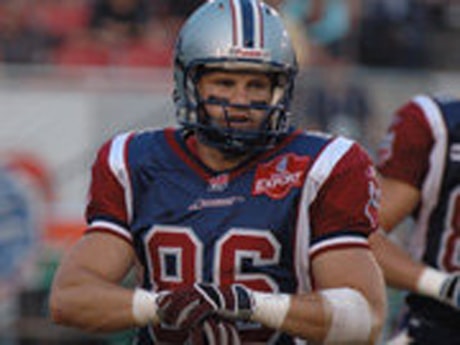Time has done little to help Ben Cahoon make sense of training camp.
The Montreal Alouettes’ slotback understands why players must gather and work on getting their timing down for the upcoming season.
But the 12-year veteran openly wonders about the need to do so with two-a-day workouts in blistering heat and long, sometimes tedious, daily meetings that often combine to beat a player down, both physically and mentally.
“I understand the history of training camp and it used to be to get people into shape,” Cahoon said via telephone from his off-season home in Utah. “But now, that’s not the case. If you show up out of shape, you’re gone.
“Everyone is showing up in shape now and I just question the logic. I can’t remember a training camp I looked forward to. Football is fun, the season is enjoyable but I think if you didn’t have to start it with a three-week training camp your attitude would be a whole lot better approaching the season.”
Cahoon, 36, twice the CFL’s top Canadian and a three-time league all-star, isn’t alone.
Montreal cornerback Davis Sanchez — a nine-year CFL veteran who also spent two seasons with the NFL’s San Diego Chargers — and Saskatchewan offensive lineman Gene Makowsky, entering his 15th campaign with the Roughriders, both openly state their dislike of training camp. But Sanchez, 34, and Makowsky, 36, also agree experience has taught them how to better prepare to face the demands of football head on.
“The last two or three years my No. 1 priority is taking care of my body and getting my body right,” said Sanchez. “I do ART (Active Release Technique) with my chiropractor and its mostly hip stuff that helps keep my body in line.
“If my hips or pelvis are rotated a bit, that’s when I’m apt to pull a hamstring or groin muscle or throw my back out. The old thought process was lifting weights to become bigger and stronger but now it’s about being more flexible, doing more cardio and making sure my body is ticking right.”
So while the five-foot-nine, 188-pound Sanchez — a native of North Delta., B.C., and two-time CFL all-star — still regularly goes to the gym, it’s not just to lift weights.
“When I was younger, I would spend five minutes at the end of my workout doing some stretching,” he said. “Now, I’ll spend 30 or 45 minutes stretching and probably do more stretching than I will working out.”
When the six-foot-three, 300-pound Makowsky, a native of Saskatoon who played collegiately at Saskatchewan, first joined the Roughriders, his off-season regiment consisted of a lot of heavy weightlifting. But the two-time winner of the CFL’s outstanding lineman award says that has changed, too.
“When I first started it was heavy weights with the bench press and squat,” he said. “Thankfully for my body the trend has gone more to balance, stability and core.
“It has helped me because I haven’t loaded up the joints with those heavy weights and instead concentrated on moving my feet more. Strength is important, don’t get me wrong, but being able to move that body weight is very important because some of those defensive linemen are really quick and on that wider field you have to be able to move.”
